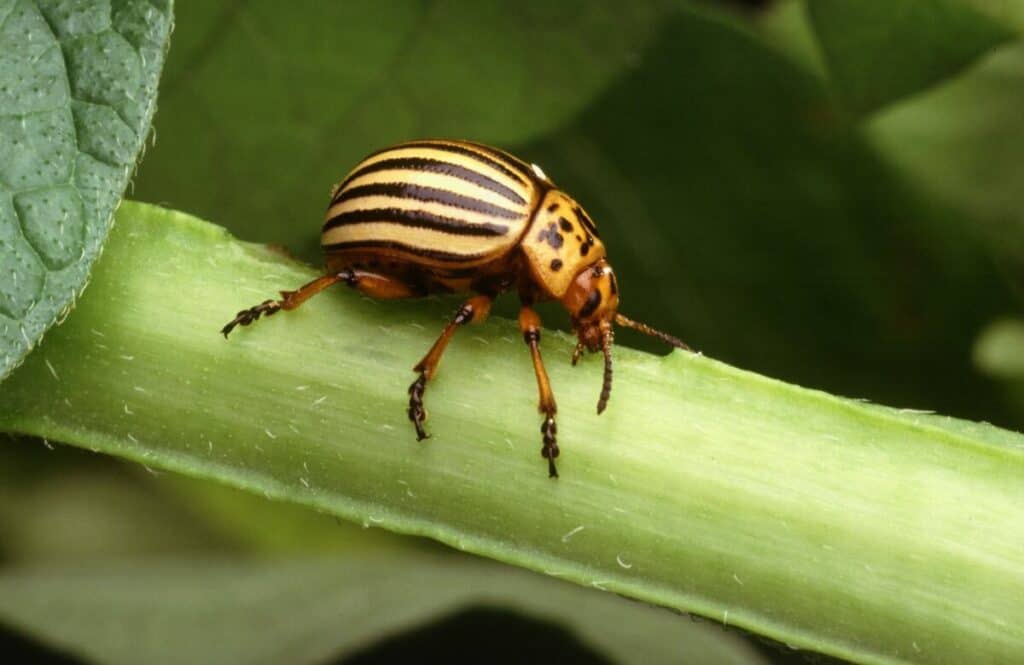Are you dealing with Colorado potato beetles in your garden? These pesky pests can cause significant damage to your plants.
This article will help you identify potato beetles and give you ways to treat and prevent them..
We’ll talk about which vegetable plants are most prone to beetle attacks and the bugs that eat them naturally..
What are potato beetles?
Colorado Potato Beetles (Leptinotarsa decemlineata) are a common pest affecting potato crops. Adult beetles are around 10mm in length, with bright yellow-orange bodies and black stripes on their wing covers. They’ve a round shape and black heads.
Their larvae are reddish-orange, with two rows of black dots on each side. Both adults and larvae feed on potato leaves, causing significant damage if left uncontrolled.
What damage do potato beetles cause on plants?
The Colorado Potato Beetles cause significant damage to potato plants by feeding on their leaves. These beetles have voracious appetites and can quickly defoliate an entire potato plant if left unchecked.
The beetles lay their eggs on the underside of potato leaves, and the larvae that hatch from these eggs also feed on the foliage. This feeding behavior weakens the plant, reducing its ability to produce potatoes.
How to identify potato beetles on plants

Check for Colorado Potato Beetles by inspecting the leaves of your potato plants for any signs of feeding damage or egg clusters.
These beetles are about a half inch long, with a yellow-orange body and black stripes on their wings. They typically lay clusters of bright yellow eggs on the underside of leaves.
The adults and larvae feed on the leaves, causing defoliation if left untreated. Regular inspection and early detection are crucial for effective pest management.
Read more:
How to get rid of potato beetles
Hand-picking: Hand-picking is one of the most effective ways to get rid of Colorado Potato Beetle infestations. It is the safest and least labor-intensive method of pest control. To hand-pick, simply walk through your garden and pick off any adult beetles or larvae you find on the plants.
Plant resistant varieties: Planting potatoes that are resistant to Colorado Potato Beetles can help reduce damage caused by these pests. Varieties such as ‘Superior’ and ‘Irish Cobbler’ are known to be less susceptible to beetle infestations, so consider planting these in your garden instead.
Use natural predators: Natural predators such as ground beetles, ladybugs, lacewings, and parasitic wasps can help keep populations of potato beetles in check. Providing a habitat for these beneficial insects in your garden can help reduce the need for chemical insecticides and other methods of pest control.
Apply insecticidal soap: Insecticidal soaps are an effective way to control potato beetle infestations when used correctly. These soaps work by suffocating the adult beetles and larvae on contact, so it’s important to apply them directly onto affected plants for best results.
Use Neem oil: Neem oil works by disrupting the life cycle of insects like potato beetles, preventing them from reproducing while also killing existing adults and larvae on contact. This natural solution is safe to use around children and pets if applied according to directions on the package label.
Read more:
- Insecticidal Soap vs Dish Soap for Pest Control
- How To Stop Insects Eating Plant Leaves
- How to Use Neem Oil and Save Your Plants
How to prevent potato beetles on plants
Rotate crops: Growing the same crop in the same area year after year can increase the likelihood of insect infestations, so be sure to rotate your crops every season.
Use row covers: Row covers are physical barriers that can prevent adult beetles from reaching and laying eggs on your potato plants. These covers should be placed over the plants as soon as they emerge from the soil in early spring.
Remove weeds: Weeds provide shelter for adult beetles and their larvae, so eliminating any nearby weed growth can help reduce populations of these pests in your garden.
Monitor frequently: Regularly inspecting your potato plants for signs of damage or egg clusters will help you identify infestations early before they have a chance to spread further throughout the garden.
Host vegetable plants for potato beetles
Potato beetles are most commonly found on potato plants, but they can also feed on other vegetables such as tomatoes, eggplants, peppers, and squash.
Natural predators of potato beetles
Various predators, such as lady beetles, toads, birds, predatory stink bugs, ground beetles, chickens, ducks, and several species of tiny parasitic wasps, prey on potato beetles.
References
- https://en.wikipedia.org/wiki/Colorado_potato_beetle
- https://entnemdept.ufl.edu/creatures/veg/leaf/potato_beetles.htm
- https://extension.umn.edu/yard-and-garden-insects/colorado-potato-beetles

Fact Checked, Written, and Published by Kevin Rodrigues
Kevin is the founder of Gardening Mentor, a website that aims to teach people to grow their own food in a limited space. As a self-taught gardener, Kevin has spent several years growing plants and creating gardening content on the website. He is certified in Home Horticulture and Organic Gardening from Oregon State University. He has a Post Graduate Diploma in Horticulture and Landscape Gardening from Mumbai University.
Read more
